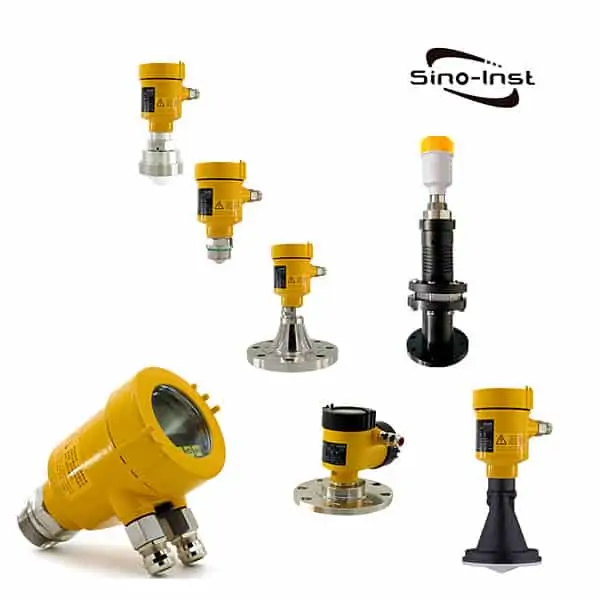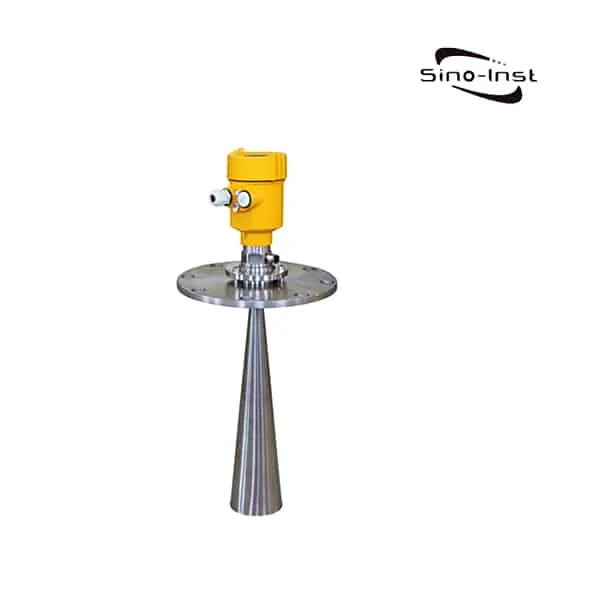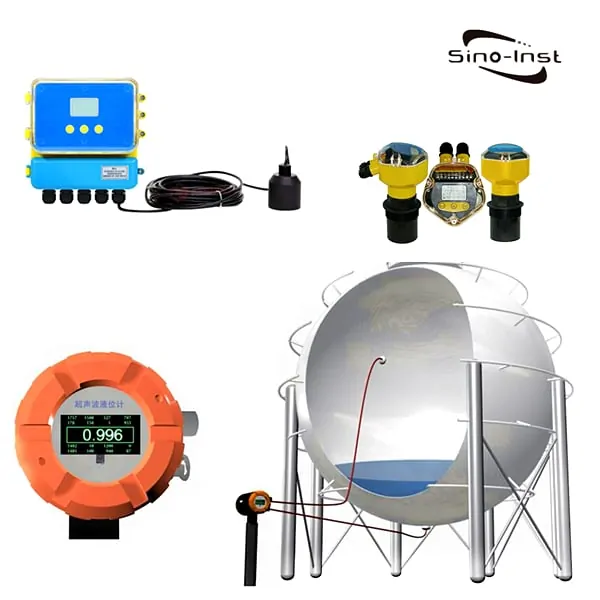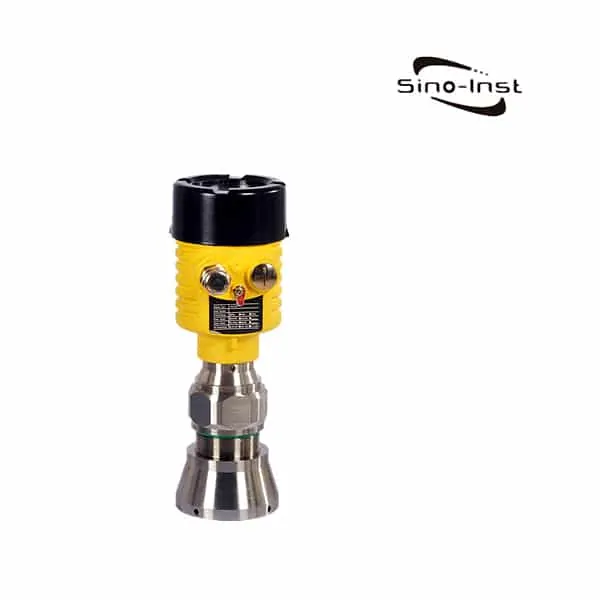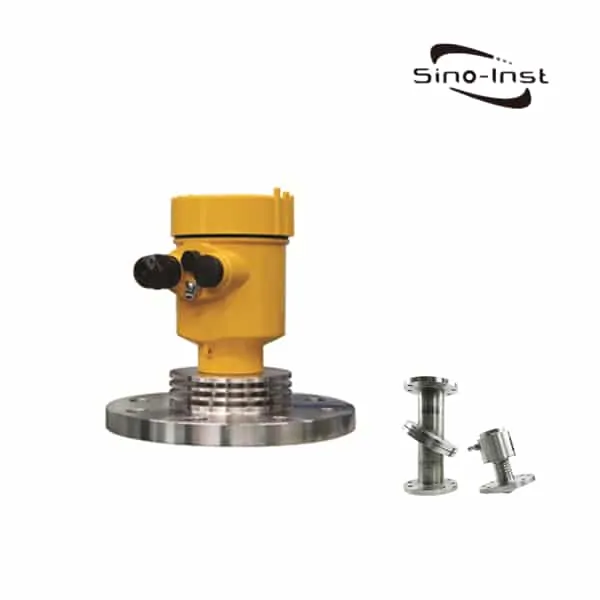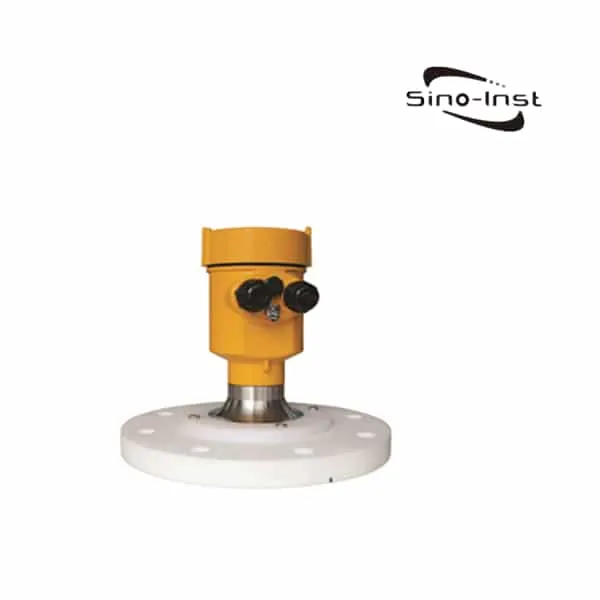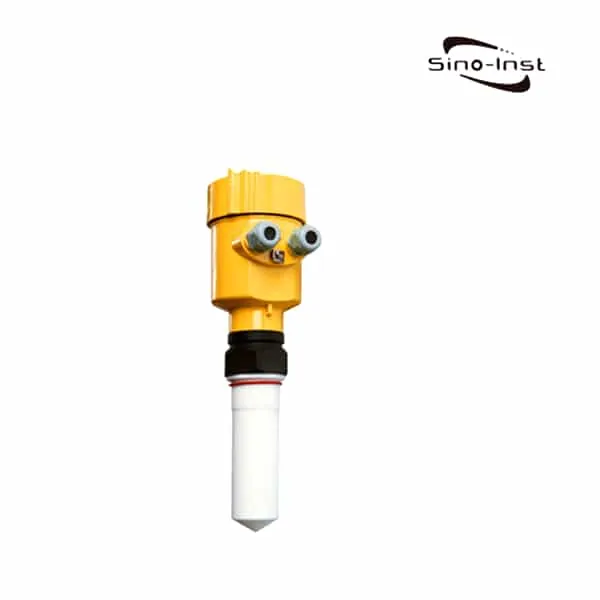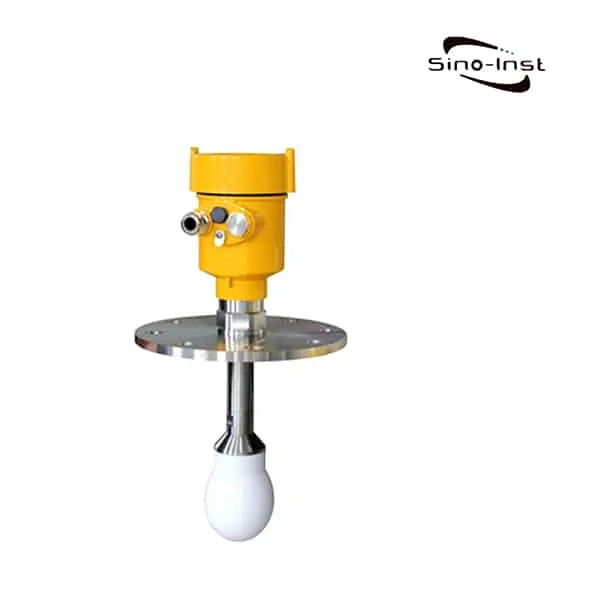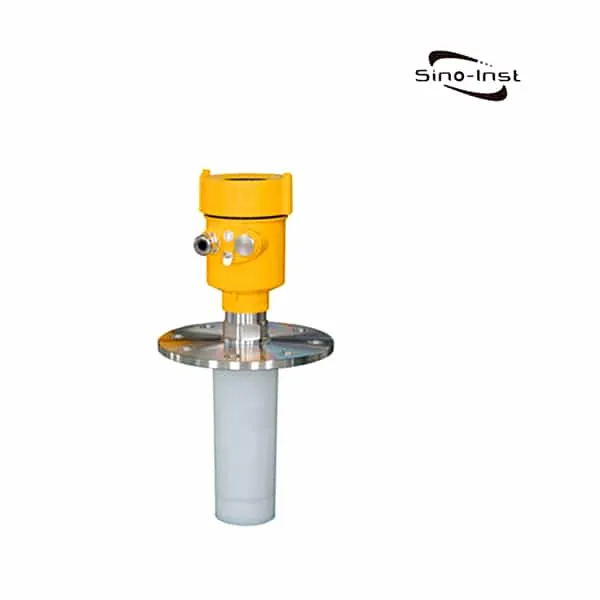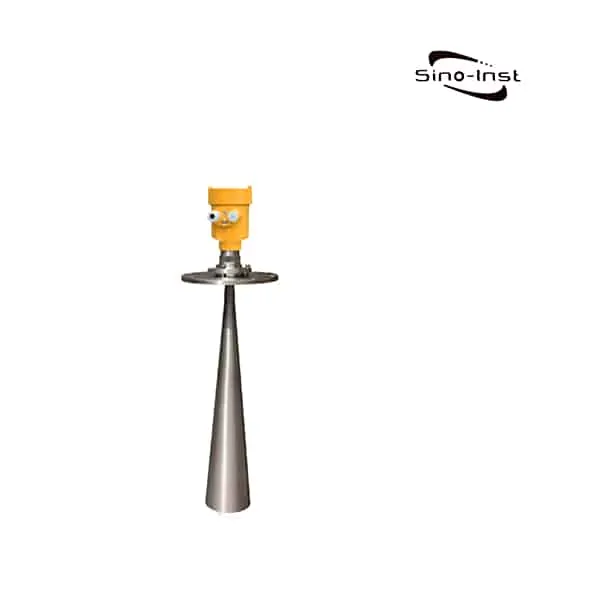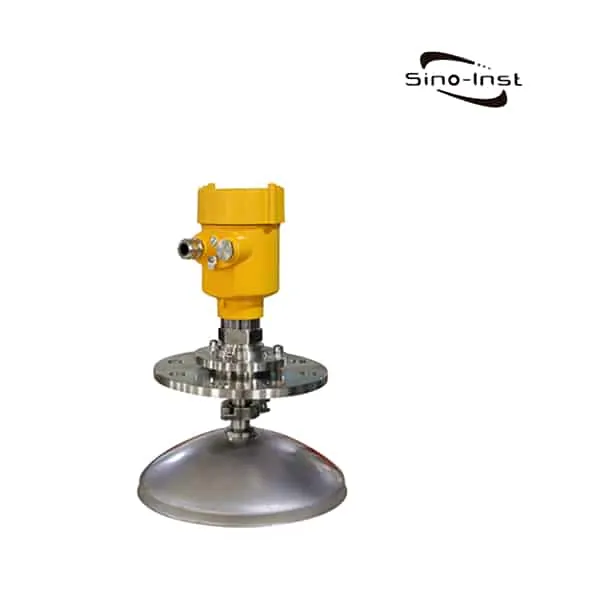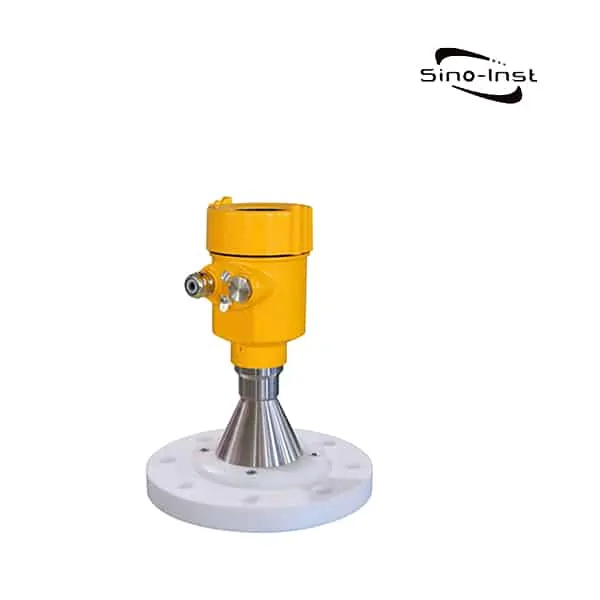FMCW Radar Level Transmitter with 120GHz fmcw, IP67 anti, can carry out 0.05m~30m Non-contact level measurement.

FMCW Radar Level Transmitter with 120G fmcw, IP67 anti, can carry out 0.05m~30m level measurement.
FMCW Radar Level Transmitter is based on the principle of FM continuous wave. FMCW refers to frequency modulated continuous wave. Use chirp high frequency signal.
120GHz FMCW Radar Level Transmitter, measuring distance up to 30 meters. The antenna is further optimized. The new and fast microprocessor can perform higher rate signal analysis and processing. The Radar Level Transmitter can be used for measuring high temperature and high pressure and other environmental liquids.
Sino-Inst offers a variety of FMCW Radar Level Transmitters for industrial level measurement. If you have any questions, please contact our sales engineers.
Features of SI-FMF11 FMCW Radar Level Transmitter
- Millimeter wave radar. The measurement accuracy is up to ±2mm. The minimum blind area for measurement is 0.05m.
- The smaller antenna size satisfies the measurement of more working conditions.
- Multiple lens antennas. Smaller launch angle. More concentrated energy. Stronger echo signal. Under the same working conditions, it has higher reliability than other radar products.
- It has stronger penetrability. It can be used normally in the case of adhesion and condensation.
- Larger dynamic signal range. The measurement of low-dielectric constant medium is more stable.
- Multiple measurement modes. The radar response time in fast measurement mode is less than 1s.
Specifications of SI-FMF11 FMCW Radar Level Transmitter
| Measuring medium: | Liquid |
| Measuring range: | 0.05m~30m |
| Process connection: | G1 ½A/1½NPT thread/flange≥DN50 |
| Process temperature: | -40~80℃ |
| Process pressure: | -0.1~0.3 MPa |
| Accuracy: | ±2mm |
| Protection level: | IP67 |
| Frequency Range: | 123GHz |
| power supply: | Two-wire system (DC24V) / Four-wire system (DC12V~24V) / Four-wire system (AC220V) |
| Explosion-proof grade: | Exia ⅡC T6 Ga / Exd IIC T6 Gb |
| Housing: | Aluminum/plastic/stainless steel |
| Signal output: | Two-wire system 4…20mA/HART protocol Four-wire system 4…20mA/RS485 Mod bus |

FMCW Radar Level Transmitter 120GHz Applications
Solid measurement
- Powder
- Granule
- Block
- ※ Low dielectric constant plastic particles
Liquid measurement
- Reactor level
- Large steam level
- Foam product level
- Crystal product level
- Ultra high temperature product level
- Ultra high pressure product level
- Hygienic product level
FMCW
What does Fmcw stand for?
FMCW, namely Frequency Modulated Continuous Wave.
FMCW technology and pulse radar technology are two technologies used in high-precision radar ranging. The basic principle is that the transmitted wave is a high-frequency continuous wave. Its frequency changes with time according to the law of triangle wave.
FMCW (Frequency Modulated Continuous Wave), the received echo frequency and the transmitted frequency change law are the same, both are triangular waves. There is only a time difference. Using this tiny time difference, the target distance can be calculated.
Extended Reading: Case: High Temperature Radar Level Transmitter for Melted Salt-Solar Photovoltaic Power Station
FMCW Radar Level Transmitter Working Principle

FM wave radar level sensor and distance formula:
Among them: C speed of light; fd Doppler frequency shift; fu triangle rising edge difference frequency; f0 FM initial frequency; T signal period; B signal bandwidth
The distance resolution depends on the frequency resolution of the DFT operation (Frequency Resolution). The frequency resolution of the DFT Fres is equal to:

①
T is the corresponding sampling time of the non-zero sampling value used for the DFT operation. If you use FFT + zero padding method to calculate the spectrum. T is the time corresponding to the sampled value of the non-zero-filled point.
The distance corresponding to the frequency resolution Fres is the range resolution Sres of the radar. Then, how to calculate the range resolution of the FMCW radar?
B: Frequency modulation width, unit Hz
T: Actual frequency modulation, in seconds
C: Speed of light, 3*10^8 meters/second
S: the distance between the radar and the object, meters
V: Frequency modulation speed, Hz/sec
t: wave propagation time, sec

V=BW/T ②
t= 2S/C ③

Assume that T is sampling during the entire frequency modulation period. And all sampling points are used for DFT calculation. According to ④ and ①,

which is

This is the calculation formula for the minimum range resolution that FMCW can obtain when the frequency modulation bandwidth is determined.
In actual use, the sampling time will be slightly shorter than the actual frequency modulation T. That is, Fres will be larger in value. So Sres will also become larger in value.
LFMCW, FMCW and Pulse radar
Radar (Radio detecting and ranging) means radio search and ranging. It is a device that uses various radio positioning methods to detect and identify various targets, determine target coordinates and other information.
In modern military and production, the role of radar is increasingly showing its importance. Especially in the Second World War, the “British” air battle between the British Air Force and the Luftwaffe made the importance of radar very clear.
The radar is composed of antenna system, transmitting device, receiving device, anti-interference equipment, display, signal processor, power supply and so on. Among them, the antenna is one of the key technologies for radar to achieve large airspace, multi-function, and multi-target. The signal processor is one of the core components of the radar with multi-function capabilities.
There are many types of radars, which can be classified in many ways:
(1) According to the positioning method, it can be divided into: active radar, semi-active radar and passive radar.
(2) According to the installation location, it can be divided into: ground radar, shipborne radar, aviation radar, satellite radar, etc.
(3) According to the type of radiation, it can be divided into: pulse radar and continuous wave radar.
(4) According to the work, it can be divided into long wave bands: meter wave radar, decimeter wave radar, centimeter wave radar and other wave band radars.
(5) According to the purpose, it can be divided into: target detection radar, reconnaissance radar, weapon control radar, flight support radar, weather radar, navigation radar, etc.
Pulse Radar
Pulse radar is a precision tracking radar. Each time it emits a pulse, the antenna can form several beams at the same time, and compare the amplitude and phase of the echo signal of each beam.
When the target is located on the antenna axis, the amplitude and phase of the echo signal of each beam are equal, and the signal difference is zero.
When the target is not on the antenna axis, the amplitude and phase of the echo signals of each beam are not equal, resulting in signal difference.
Drive the antenna to the target until the antenna axis is aligned with the target, so that the high and low angle and azimuth angle of the target can be measured.
The sum of the signals received by each beam can measure the distance of the target. In order to realize the measurement and tracking of the target.
FMCW
FM continuous wave radar refers to a continuous wave radar whose transmitting frequency is modulated by a specific signal, such as weather radar.
FM continuous wave radar obtains the distance information of the target by comparing the difference between the frequency of the echo signal at any time and the frequency of the transmitted signal at that time.
The distance is proportional to the frequency difference between the two. The radial velocity and distance of the target can be obtained by processing the measured frequency difference between the two.
Compared with other range and speed measurement radars, the structure of FM continuous wave radar is simpler.
FMCW radar has rich technical experience, low transmit power peak required, easy modulation, low cost, and simple signal processing, so it is a commonly used radar system in automotive radars.
LFMCW radar, i.e., the carrier signal frequency changes linearly with time.
More Featured Radar Level Transmitter
Frequently
Asked
Questions
Sino-Inst offers over 10 FMCW Radar Level Transmitters for level measurement. About 50% of these are float liquid level meters, 40% is the Solid level sensors.
A wide variety of FMCW Radar Level Transmitters options are available to you, such as free samples, paid samples.
Sino-Inst is a globally recognized supplier and manufacturer of FMCW Radar Level Transmitters instrumentation, located in China.
Request a Quote

Wu Peng, born in 1980, is a highly respected and accomplished male engineer with extensive experience in the field of automation. With over 20 years of industry experience, Wu has made significant contributions to both academia and engineering projects.
Throughout his career, Wu Peng has participated in numerous national and international engineering projects. Some of his most notable projects include the development of an intelligent control system for oil refineries, the design of a cutting-edge distributed control system for petrochemical plants, and the optimization of control algorithms for natural gas pipelines.

